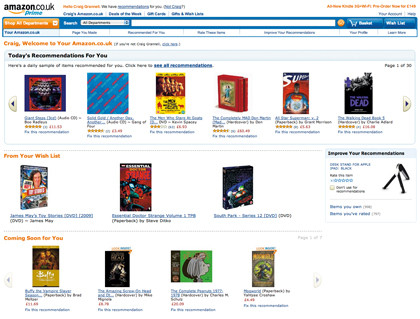How to keep people on your website

Today's consumers have more choice than ever, especially online. Competing attractions are just a click away, so it's vital to engage your audience's attention and give them a reason to stay on your site – and want to come back to it again and again.
This elusive component of web design is often referred to as 'stickiness'. Stickiness is important for various reasons.
"Getting a user to return frequently is more cost-effective than trying to convince new users to come to a site," points out Pod1 ecommerce strategist David Hefendehl. Once users are engaged, "adopters will help you to spread the word and promote your site," adds Abduzeedo founder and designer Fabio Sasso.
The right kind of sticky It's critical that stickiness stems from positive user experience, leading to loyalty and users not wanting to leave. "When designing, never think of literally getting people stuck," says cxpartners principal consultant James Chudley.
"I've heard of nasty UX where important information has been made deliberately hard to locate, 'trapping' users. Instead, focus on users' needs and serve them well. As a result, you'll get the kind of 'stickiness' you want."
Also be careful who you use the phrase 'stickiness' around, adds Digitaria senior web analyst Dexter Bustarde. "It's a popular web industry term but it carries a natural negative connotation to most outside the industry," he points out.
When talking to clients who don't themselves bring up the phrase 'stickiness', Bustarde suggests using the term 'essential' instead. "Having an 'essential' site is aspirational, while still capturing everything web developers and marketers think of when using the term 'sticky'."
Sign up for breaking news, reviews, opinion, top tech deals, and more.
First impressions
Design is integral to a site's stickiness. "People react to gut instinct," Chudley says. "If a site doesn't look professionally designed, they won't stick around – particularly if they're looking to buy something."
Bluhalo's marketing and business development manager Jocelyn Kirby concurs. "Looks matter," she says. "First impressions count. Before contemplating a return visit, a user must engage with a website." In providing a user with what they're looking for, in a usable format that looks good, you're partway towards achieving stickiness.
The ideal is to not make people think. "Optimise a site's design to deliver the most intuitive user experience, and deliver the desired end result to the user with little effort," continues Kirby. "This contributes to the likelihood of the user returning."
Of course, good first impressions are just the starting point: you have to make them last. A strong design is one that doesn't just look pretty but guides users and encourages them to interact or share.
"Visuals and branding are important, but what's important is how those visuals and branding are integrated with the structure underneath the surface layer," says Bustarde. "You can have a gorgeous looking layout, but it has to work. If a visitor clicks on what looks like a compelling button but it doesn't really do anything, you've hurt yourself twice: you've presented something that feels broken and discouraging, and you've missed out on the opportunity that was created with your great visual cue."
Style and substance
Underpinning visuals and structure is content, arguably the most important single component when it comes to stickiness. To get repeat visits BKWLD's director of interactive production Dan Fields suggests "putting what's most useful and compelling in the most logical, strategic position".
Fields points out that once a 'visual language' is created and a user knows where to find sticky content, it's easy to train them to find it, helping to ensure they'll stick around. In the fight for eyes and hits, video is definitely worth considering.
"We're constantly visually stimulated, and video often achieves engagement where text and imagery cannot," says Kirby. "Regularly updated videos maximise repeat visits from people looking for new content.
"Since video hasn't seen the amount of contribution text content has, early, enthusiastic adopters will reap the benefits in natural search rankings, given the relatively low amount of existing competition compared to blogs and websites."
However, video by its nature takes time to consume, and so Chudley warns that it "should be of a duration commensurate with the nature of what's being conveyed," adding that he recently saw a 25-minute video for a web service that should have been a quickfire elevator pitch. The result: zero stickiness.
Social engagement
Compelling content within a strong, usable design will guarantee some stickiness, then. But the relentless march of Facebook and Amazon suggests that reactive design is increasingly important.

Sites that react to users' needs can result in longer session times and encourage return visits. Customisation involves a personal investment on behalf of the user, and when someone has given time to a site, they're more likely to become loyal.
"The method to choose depends on your site and audience," says Sasso. "If you can automatically provide reactive design, that's often better than making users customise things themselves, because that comes with a learning curve."
With Facebook having trained people to click on 'like' buttons, a low level of active participation should be fine for most sites to increase stickiness.
We Love copywriter
Melissa Bennett suggests this will soon become commonplace. "Facebook plugins vary from enabling users to 'like' or recommend things to allowing users to make comments and show profile pictures of friends who've already signed up – they're essentially letting brands encourage users to explore more," she says.
"And what I see when looking at a site with a Facebook login will be different to what a friend sees. In the future, sites will be completely relevant to individual users. This will make them extremely sticky: by making content relevant and contextual, catering to what we want to see, a site will create loyalty."
However, Bustarde warns that anyone focusing on a similar kind of targeted content must "avoid the creepy sensation that comes with seeming to know too much about your visitors" – a problem Facebook's arguably having to deal with.
Other means of social engagement can also enhance stickiness. Hefendehl cites Gurgle.com, the Mothercare-backed community for first-time parents. "It's run as a non-direct sales channel," he explains. "By identifying a need for a core target market, the site offers sticky content in the form of help for parents."
Others tap into existing networks such as Flickr, YouTube and Twitter. "These are all great tools to achieve extra stickiness," says Jonathan Smiley of design company ZURB. "People come from these sites and spend incredible amounts of time on ZURB.com. Why? Because they want to learn more after viewing one of our videos or reading our tweets."
The important thing is to ensure the sense of community always remains – poor management of social media can harm perception of a brand, which can wreck stickiness. With communities in place and visitors returning, it's useful to examine additional outreach possibilities, although Hefendehl says to be mindful that most people aren't techies.
"RSS readers are good to push content out, but are limited to a very small percentage of people who use them and understand what they do. Newsletters and email marketing are more effective tools to get users back to your site. A carefully planned email strategy will pay for itself in no time."
Even better, he says, is to find a way to enable user-generated content: "Everyone loves seeing their content published or their comments picked up by a website's owner."